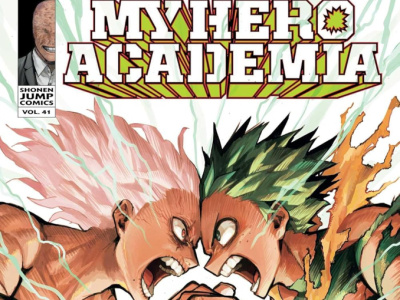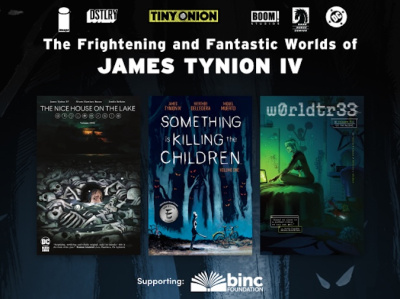
We recently spoke to Liza Coppola, Viz Media Vice President Sales and Marketing, about the North American manga and anime markets and Viz's place in them. In Part 2, we talk about the Viz consumers, manga production and frequency, and Viz's intellectual property launch strategy. In Part 1, we talked about Viz's TV-driven hits, the openings for shojo in the U.S. market, and the Viz anthology titles. In Part 3, we talk about cut and uncut anime editions, fan downloads, and DVD pricing. And in Part 4, we talk about American manga- and anime-influenced productions, and the bookstore, mass merchant, and comic store channels for manga.
Taken as a whole, how do the demographics of the readers of the Viz manga line break down by sex?
I think pretty similar to everybody else's: about 60% female, 40% male. It's just because of the properties. At Comic-Con we had three generations of InuYasha fans--literally it was a five-year-old girl, her mother, and the grandmother. They were all InuYasha fans and they all came dressed as characters; they all picked different characters. You had three generations of females watching InuYasha. So it depends on each property.
What's the range? For example, do you have any 90% titles either way, or are they all clustered around the middle?
The majority of them are clustered around the middle. I don't think we have anything that is that extreme. There are some titles that have a little bit more fan service, so you do have titles that are a little bit more geared toward a male demographic. There's always a surprise here and there. Kenshin you would think would be towards boys, but it really isn't. The breakdown for Kenshin is really 50/50.
In terms of your manga output, about how many manga titles per month are you averaging right now, and where do you see that going over the next year?
I can't give you exact numbers, but we are increasing next year. Part of the benefit of being owned by Shogakukan and Shueisha is that we have all this great content coming down. We do have a lot more properties coming down for next year. We're also publishing 1 World Manga, in a partnership with the World Bank. And there are so many big properties there, not just in the book format, but also through Profiles, through fiction, and we are taking a look at releasing properties in a different way, in a different format. So not only would you have Fullmetal Alchemist in the manga, but you'd also have it in an art book, or you'd have it in a novel. So by property, it's a little bit different than by units.
You've been experimenting with a monthly frequency, on Kenshin, for example. How do you evaluate the results of that, and is that something you're going to continue, expand, or reduce?
The monthly question is a very good question. We have done experiments on monthly and it was a good experiment; it was definitely something we needed to do. But we do want to really let a series grow, and take its time and marinate. So I think part of the problem is that you have consumers that are saying, 'We want it out; we want it immediately; can you get it out a little bit faster?' And then you have retailers that are saying, 'Wait. Give us a little bit more time to have it on the shelf.' You run a gauntlet between the two issues. For us, we are going to try to take the right amount of time for each property, and I don't think we're going to do monthly much more, quite honestly.
So you felt like it restricted the sales because it just wasn't out there long enough?
It wasn't out there long enough, and it was a little more difficult for us. We have so many properties, so many titles that go out every month. Between us, between Tokyopop, between Del Rey, and everybody else it gets a little crazy out there. Especially when you have Naruto out there; you have Fullmetal Alchemist; you have Kenshin; you have InuYasha; you have all these hot properties, and you want to make sure they have time to make it into the marketplace. And you want to make sure that everyone has time to pick up that volume before you move on to the next volume. Nobody's given you a good answer on that one, have they?
The answers have varied. In the [Tokyopop Publisher Mike] Kiley interview, he said, 'We might do some seasonally. In some seasons we might pick up the frequency, and expand it out in other seasons.' So the answers have been different.
Seasonality is an interesting one as well. What we try to do is to train our consumers so they know that our titles come out on the second Tuesday of the month, so there are certain titles they go out and look for in that time period. So we really try not to move schedules around, and that's a commitment that we've made. Especially since Simon and Schuster is going to be handling our sales next year, we really just want to make sure that the dates are set, they're not shifting around here and there. It's just confusing for everybody. And we do advertise in the magazines, in Shonen Jump, in Shojo Beat, and in our Best Buy Animerica or our Borders/Waldenbooks Animerica what those dates are.
We alluded to this earlier when we talked about the role of the anthologies. In the United States there are times when companies try to launch an intellectual property across multiple platforms and categories all at the same time, and they might try to coordinate a new program on television with a toy release, and a comic release, and so forth. Viz seems to be pursuing a more Japanese style, in the sense that the manga comes out first (sometimes in an anthology first, sometimes straight to collections), then the anime, then licensing. Naruto is an example. You announced a toy license, which was after the manga was out for a while, after it's been on TV, and before the anime DVDs, which are going to be coming out early next year. Is this a strategy or just the way things are working out?
It is an over-all strategy. It's part of the reason why we merged ShoPro and Viz. Part of the reason is because we would have a lot more synergy across all platforms, and we would be able to sit down and say, 'Ok, let's roll it out this way. Let's have the manga come out. Let's look at the consumer products division and determine what's going to come out and when it's going to come out and what's going to have the most impact.' It allows the cross-promotions between the different categories so we can work together with the Mattels and the Nintendos and the Cartoon Networks and really build. You'll see this next year.
What we're looking to do is build tentpoles every year for our licensees so we can have one major program in each peak period, whether it's holiday, or back to school, or summertime. There will be tentpoles that are built through marketing that will reach out to all the different licensees. It's really going to enable us to extend the life of each property. In the past when there were different people that were responsible for different areas there wasn't as much synergy, there wasn't as much communication going back and forth. Everything is very strategic, so even the announcement of the press release is timed, and all of it is to keep it going and to extend the life of that property, through not only next year, but ongoing.
As an example, you were very strong behind the InuYasha feature release. You had the mobile theater tour; I was also seeing InuYasha figures in many stores. I assume that was all part of this tentpole strategy?
InuYasha actually happened before the merger, but InuYasha really helped reinforce the fact that we all work together really well as a team. It really made a lot more sense to merge and have it be official. But we all realized how well it all is integrated between the mobile theater, we did promotions with Bandai.... ShoPro has always been on the other side of the wall in the same building, so that synergy already was there, but this way we sit down on a monthly schedule to go through all the different launches, to go through if we have a hot property coming down, when do we want to have TV, when do we want to have home video, when do we want to have the different properties launching. InuYasha happened before the merger, but it was definitely a great case study for us to know that we all worked together really well. But it really made much more sense to make it formal.







